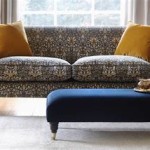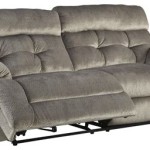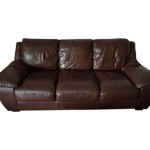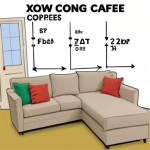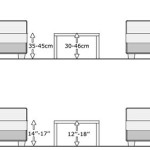Wooden Sofa Frames: A Foundation of Quality and Style
A sofa is often the centerpiece of a living room, enduring daily use and contributing significantly to a room's aesthetic. The frame, though unseen, plays a crucial role in the sofa's longevity, comfort, and overall quality. Understanding the nuances of wooden sofa frames can empower consumers to make informed decisions and invest in furniture that stands the test of time.
Key Considerations When Choosing a Wooden Sofa Frame
Several factors contribute to the quality and durability of a wooden sofa frame. Examining these elements provides valuable insight into the construction and expected lifespan of the piece.
*
Type of Wood:
Different wood species offer varying levels of strength and durability. Hardwoods like oak, ash, and maple are favored for their robustness and resistance to wear and tear. Softwoods like pine and fir are less expensive but may not offer the same longevity. *Kiln-Drying:
Kiln-dried wood is crucial for preventing warping, cracking, and insect infestation. This process removes excess moisture, ensuring dimensional stability and reducing the likelihood of future problems. *Joinery Techniques:
The methods used to connect the wooden components significantly influence the frame's strength. Traditional joinery techniques like doweling, mortise and tenon, and dovetailing offer superior strength and durability compared to staples, nails, or glue alone. *Corner Blocks:
Reinforced corners using corner blocks, ideally glued and screwed, contribute to the frame's structural integrity and prevent it from becoming loose or wobbly over time.Types of Wood Used in Sofa Frames
The species of wood used significantly impacts the frame's performance and price point. Understanding the characteristics of different woods helps in selecting a sofa that aligns with individual needs and budget.
*
Hardwoods:
Known for their density and durability, hardwoods like oak, maple, ash, and walnut are ideal for high-traffic areas and provide a solid foundation for long-lasting sofas. They tend to be more expensive than softwoods. *Softwoods:
Pine and fir are commonly used softwoods in sofa construction. While less expensive, they are more susceptible to dents and scratches and may not hold up as well over time compared to hardwoods. *Engineered Wood:
Materials like plywood and particleboard are sometimes used in less expensive sofa frames. While cost-effective, they are generally less durable than solid wood and more susceptible to moisture damage.Construction Techniques and Their Impact on Durability
The way a wooden frame is constructed plays a vital role in its strength and longevity. Various joinery techniques and reinforcement methods contribute to the overall quality of the frame.
*
Mortise and Tenon:
A time-tested method, mortise and tenon joints interlock pieces of wood, creating a strong and stable connection. *Doweling:
Dowels reinforce joints by providing additional support and preventing the wood from shifting. *Dovetailing:
This technique uses interlocking wedge-shaped joints, renowned for their strength and resistance to pulling forces. *Staples and Nails:
While quicker and less expensive, relying solely on staples or nails can result in a weaker frame that is more prone to loosening over time. *Glue:
Wood glue, when used in conjunction with other joinery methods, adds significant strength and stability.Identifying a Quality Wooden Frame
When shopping for a sofa, assessing the quality of the frame is crucial. Certain indicators can help determine the construction and durability.
*
Weight:
A heavier sofa often indicates a more robust frame constructed with solid wood. *Joints:
Inspect the joints for signs of quality construction like dowels, corner blocks, and robust joinery techniques. Avoid frames held together primarily with staples or nails. *Wood Type:
Inquire about the type of wood used. Hardwoods are generally preferred for their durability. *Warranty:
A manufacturer's warranty on the frame can provide peace of mind and indicate confidence in the product's construction.Caring for a Wooden Sofa Frame
Proper care and maintenance can extend the lifespan of a wooden sofa frame and keep it looking its best.
*
Regular Dusting:
Dusting prevents the buildup of grime that can scratch the wood's surface. *Avoid Excessive Moisture:
Spills should be cleaned promptly to prevent moisture damage. *Temperature and Humidity Control:
Maintaining a stable environment helps prevent warping and cracking. *Professional Upholstery Cleaning:
Periodic professional cleaning can remove deep-seated dirt and refresh the fabric, protecting the frame from wear and tear.The Importance of a Strong Foundation
Investing in a sofa with a well-constructed wooden frame is an investment in long-term comfort and style. A strong frame provides the necessary support for the cushions and upholstery, ensuring the sofa retains its shape and comfort for years to come. Understanding the elements of a quality wooden frame empowers consumers to make informed decisions and choose a sofa that meets their needs and budget.

James Furniture Frames Built Sofa Wood Frame Wooden Designs

Devale Wood Frame Sofa Cozymatic Us

Wood Wooden Sofa Frame Shape L

Scandinavian Wood Frame Sofa Solid Sweden

Sofa Frames What Kind Are The Best Stated Home Blog

Chelan 3 Seat Exposed Wood Frame Sofa From Dutchcrafters Amish

Wood Sofa Frame Shape Horizontal

Modern Sofa Mid Century Frame Couch

Low Seating Wooden Sofa With Solid Wood Frame A Sofá De Madeira Móveis Paletes Idéias Para Mobília

Which Wood Type Is Perfect For Sofa Frames Just Furniture

